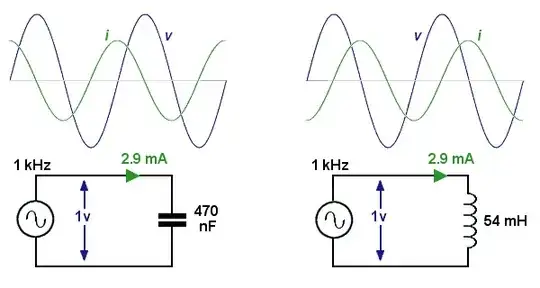Suppose a RLC circuit with AC source. Why the net reactive power in the circuit is the difference of reactive power in the inductor and the reactive power in the capacitor ? As both of them store power then why the reactive power in them is not added instead of subtraction.
2 Answers
Current leads voltage in a capacitor. Voltage leads current in an inductor. I was taught this using the CIVIL spelling:
In a C I leads V leads I in an L. (I hope that makes sense.)
The effect is that the voltage or current will be 180° out of phase between the inductor and the capacitor and so in summing them they tend to cancel out rather than add.
As both of them store power then why the reactive power in them is not added instead of subtraction.
Both of them store energy but one will be maximum while the other is minimum. This effect is seen best in the resonant circuits where the energy flows back and forth between the inductive and capacitive elements.
- 175,532
- 13
- 190
- 404
As both of them store power then why the reactive power in them is not added instead of subtraction.
Both of them store energy not power. Power is the rate at which energy is stored or transferred. Anyway, moving on...
For a capacitor Q = CV and if you differentiate Q you get: -
\$\dfrac{dQ}{dt} = C\dfrac{dV}{dt}\$ and, of course rate of change of Q is current therefore you can say: -
\$I = C\dfrac{dV}{dt}\$. This means if the applied voltage (V) is a sinewave then the current is a cosine wave: -
Now if you looked at an inductor you would find that \$V = L\dfrac{dI}{dt}\$.
If you integrated both sides to find I then you would see that \$I = \dfrac{\int{V}\cdot dt}{L}\$.
Clearly if V is a sinewave then I must be a negative cosine wave. Here are the two scenarios side by side: -
So, if you have an L and a C in parallel across a sinewave voltage source, then the current in the inductor is exactly opposite in polarity to the current in the capacitor i.e. while one is taking energy from V, the other is delivering energy back to V. This gives rise to the currents being subtracted.
It's also notable that when the impedances are identical (one specific frequency) as indicated on the diagram immediately above, the net current into a parallel LC is zero i.e. they behave together as an infinite impedance. This is called parallel resonance and is extensively used in radio. It's also called power factor correction in electrical engineering; you find a value of capacitance that keeps the PF unity thus keeping the reactive energy "consumed" to a minimum.
- 456,226
- 28
- 367
- 807
-
thanks a lot for your reply. it was very helpful. can you please further tell me that if the circuit is series RLC circuit then what will be the phase difference between inductor voltage and capacitor voltage ? in this case the current in the inductor will be exactly opposite in polarity to the current in the capacitor also ? can you please explain that ? – hur chu chu Jan 27 '16 at 10:11
-
In a series circuit the current has to be the same so now, the voltage across the inductor will lead the "common" current by 90 degrees and the voltage across the capacitor will lag the "common" current by 90 degrees hence, inductor and capacitor voltages are 180 degrees apart or they are inverse to each other. – Andy aka Jan 27 '16 at 10:14
-
oh so again the power in capacitor and inductor would be opposite P=VI. great. thanks alot. i really appreciate. :) God bless you. – hur chu chu Jan 27 '16 at 10:21
-
you have clarified it. i do not have any confusion now. do you think there is any confusion left after your clarification ? – hur chu chu Jan 28 '16 at 12:21
-
@hurchuchu OK then maybe you can consider pressing the "accept answer" button located below the up/down arrows at the left-top of my answer? – Andy aka Jan 28 '16 at 12:35
-
i did that but i just joined this site few days ago and do have have the required score. i will definitely do that later when i will fulfill the requirement for that. – hur chu chu Jan 28 '16 at 12:39
-
Yes you can - it's below the up and down arrows - you raised the question and you can "accept" the answer no matter what your reputation score is. – Andy aka Jan 28 '16 at 15:58
-
please answer to my this question if you are easy with that. i shall be grateful to you. http://electronics.stackexchange.com/questions/214964/why-do-we-need-to-rectify-or-amplify-the-current-voltage – hur chu chu Feb 02 '16 at 21:15
-
@hurchuchu I'd love to answer the question but I think you need to make it more accessible - it doesn't make sense at the moment - you talk of shapes to voltage and current but I'm unsure what you mean. – Andy aka Feb 02 '16 at 21:18
-
just tell why do we need to rectify the current ? for what purpose its required ? – hur chu chu Feb 02 '16 at 21:20
-
I've left the best comment I can under the question and Olin has made an answer similar to my comment. – Andy aka Feb 02 '16 at 21:23

